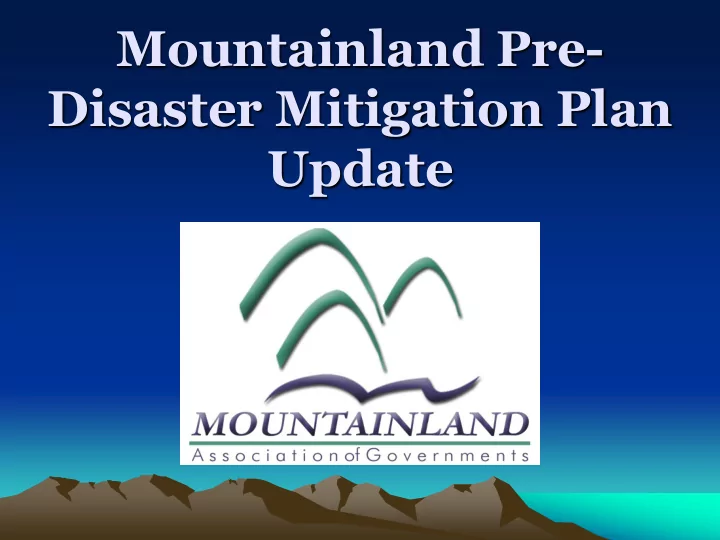

Mountainland Pre- Disaster Mitigation Plan Update
Background • Federal agencies such as the Federal Emergency Management Agency (FEMA) are attempting to break the cycle of disaster, disaster recovery, yet another disaster, through this mitigation planning initiative. • Disaster Mitigation Act of 2000 (Stafford Act)
The Pre Disaster Mitigation Program • The Pre-Disaster Mitigation (PDM) program provides funds to States, Territories, Federally- recognized Indian tribal governments, and communities for hazard mitigation planning and the implementation of mitigation projects prior to a disaster event. Funding these plans and projects reduces overall risks to the population and structures, while also reducing reliance on funding from actual disaster declarations.
Our Purpose – Help communities mitigate hazard damages through planning. – Make each participating jurisdiction eligible to apply for FEMA PDM grants to conduct mitigation projects. • Participation in the process • Plan adoption – Each participating jurisdiction will also be eligible some for additional post disaster funding.
Old Plan • Completed in 2004 • Adopted in 2005 • Integrated into the Statewide Pre-Disaster Hazard Mitigation Plan • Needs to be updated according to federal law.
Planning Tasks • Establish a Planning Team • Risk Assessment • Mitigation Strategies • Plan Adoption
Planning Team • Each mayor or commissioner was asked to send one staff member (planner, engineer, emergency services) to meetings. • Each jurisdiction was represented.
Risk Assessment Process 1. Identify Hazards 2. Profile 3. Regional Inventory 4. Estimate Losses
Hazard Profile (Earthquake) Frequency Low -Events above 3.0 on the Richter scale are rare. Minor events (below 3.0) occur every month. Severity High (up to 7.0) Location Multiple faults throughout the county with the primary Wasatch Fault along the mountain benches. Seasonal Pattern None Duration 1 to 6 minutes excluding aftershocks. Speed of Onset Seconds Probability of Future Low- .13 (events above 3.0) Occurrences Recorded Earthquakes magnitude 3.0 or greater since 1950: Utah County Date Richter Magnitude Epicenter February 20, 1950 3.7 Payson May 8, 1950 4.3 Payson August 12, 1951 4.3 Provo July 21, 1952 3.7 Santaquin September 28, 1952 4.3 Lehi July 27, 1971 3.0 Near Lehi August 5, 1973 3.2 Northeast of Orem May 24, 1980 4.4 Elberta
Flood & Dam Failure
Wildland Fire
Earthquake, Liquefaction & Landslide
Lost Estimate Analysis • Earthquake • Flood • Landslide • Wildland Fire • Dam Failure HAZUS GIS Analysis • Building Inventory (HAZUS, Building Permits, Assessors' Data) • Critical Facilities (Police, Fire, Hospital, & Schools) • Critical Lifelines (Roads & Bridges)
Utah County Loss Estimates Critical Residential Commercial Bridges Roads Facilities Hazard Planned Planned Count Cost Count Cost Count Cost Length (mi) Cost Count Units Jobs Dam Failure 34,146 $4,883,508,400 1337 4,407 $1,858,312,400 2270 108 $61,957,000 651 $3,388,066,200 80 FEMA Flood Plain 2,053 $223,241,400 326 212 $79,660,400 990 34 $12,881,000 60 $318,135,100 6 HAZUS Flood 2,271 $228,484,100 138 294 $139,800,600 110 16 $4,455,000 73 $347,264,600 1 Landslide 9,120 $1,134,815,400 85 785 $242,297,600 60 13 $3,038,990 247 $940,019,200 5 Wild Fire 8,614 $863,816,500 1506 591 $202,124,800 910 41 $13,171,990 883 $3,109,850,900 7 Earthquake 58,449 $9,445,163,028 1,935 $1,506,695,509 339 $1,818,707,537 106
Mitigation Federal Requirement : Each participating jurisdiction must have at least two mitigation actions for each hazard present within its boundaries. • Protects current residents and structures . • Protects future residents and structures.
Basic Strategies Table Protecting Current Residents and Structures Potential Funding Hazard Action Priority Timeline Estimated Cost Sources Flooding/Dam Failure Promote NFIP participation. High Ongoing Minimal Local Cash, Grants Earthquake Inventory current critical facilities for seismic standards. High 3 years TBD Local Cash, Grants Wildfire Educate homeowners on FIREWISE practices. High Ongoing Minimal Local Cash, Grants Public education on and correct watering practices and retaining measures Landslide in susceptible areas. Medium 1 year TBD Local Cash, Grants Regional Hazards Local cash, Grants, Drought Promote water conservation programs "Slow the Flow". Medium Ongoing Minimal UDWR, CUWCU Severe Weather Public preparedness campaign. Medium Ongoing Minimal Local Cash, Grants Infestation Public education on eradication programs. Medium Ongoing Minimal Local Cash, Grants, UDAF Protecting Future Residents and Structures Potential Funding Hazard Action Priority Timeline Estimated Cost Sources Update Flood and Inundation mapping and incorporate them into general Flooding/Dam Failure plans and ordinances. High 2 years TBD Local Cash, Grants Earthquake Promote earthquake awareness and preparation. High 1 year Minimal Local Cash, Grants Incorporate FIREWISE landscaping requirements into local ordinances Wildfire within areas at risk. High 1 year Minimal Local Cash, Grants Coordinate and update landslide mapping within the area with UGS and Landslide USGS. High 3 years Minimal Local Cash, Grants Regional Hazards Drought Consider the enactment of water wise landscaping ordinances. High 1 year Minimal Local Cash, Grants Grants, FEMA, NOAA, Severe Weather Increase the number of weather stations. Medium 5 years TBD UDOT Infestation Support invasive species protection programs. Medium Ongoing Minimal Local Cash, Grants, UDAF
Mitigation • A project does not need to be listed in the plan to be eligible to apply for a grant. • If you do eventually want to pursue a grant, we can amend the plan to list that particular project in order to strengthen your application.
New Plan • Has been approved by State Division of Homeland Security and FEMA Region VIII. • Available at www.mountainland.org/hazards
New Plan Chapters 1. Executive Summary 2. Plan Prerequisites 3. Planning Process 4. Risk Assessment 5. Regional Hazards 6. Summit County Profiles and Mitigation 7. Utah County Profiles and Mitigation 8. Wasatch County Profiles and Mitigation 9. Plan Maintenance 10.Capability Assessment 11.Annex
Adoption • Following FEMA approval, each jurisdiction must adopt the plan by resolution in order to be eligible. • A sample resolution is available and distributed with the plan.
Adoption How can we help you with the resolution process?
www.mountainland.org/hazard Bob Allen (801) 229-3813 rallen@mountainland.org
Recommend
More recommend